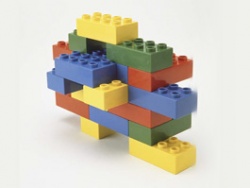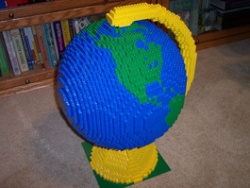Semantic Web
From Computing and Software Wiki
| (4 intermediate revisions not shown) | |||
| Line 1: | Line 1: | ||
| - | The Semantic Web is a progressive extension of the World Wide Web that adds the semantic representation of data. | + | The Semantic Web is a progressive extension of the World Wide Web that adds the semantic representation of data. Semantic comes from the Greek word semainein, meaning to signify. In linguistics, semantics is the study of meaning as inherent to words, phrases and sentences. The initiative to contextualize the Web is driven by the World Wide World Consortium (W3C). At its core, it consists of a family of technologies that specify how information on the Web should be structured, organized and accessed.[1] |
| - | The original World Wide Web was created in 1989 by technologist, Tim Berners-Lee. | + | The original World Wide Web was created in 1989 by technologist, Tim Berners-Lee.[2] Ten years later, Tim introduced a new concept where machines communicate information with other machines called the Semantic Web. |
| - | "I have a dream for the Web [in which computers] become capable of analyzing all the data on the Web – the content, links, and transactions between people and computers. A ‘Semantic Web’, which should make this possible, has yet to emerge, but when it does, the day-to-day mechanisms of trade, bureaucracy and our daily lives will be handled by machines talking to machines. The ‘intelligent agents’ people have touted for ages will finally materialize." -Tim Berners-Lee, 1999 | + | "I have a dream for the Web [in which computers] become capable of analyzing all the data on the Web – the content, links, and transactions between people and computers. A ‘Semantic Web’, which should make this possible, has yet to emerge, but when it does, the day-to-day mechanisms of trade, bureaucracy and our daily lives will be handled by machines talking to machines. The ‘intelligent agents’ people have touted for ages will finally materialize." -Tim Berners-Lee, 1999[1] |
__TOC__ | __TOC__ | ||
| Line 16: | Line 16: | ||
In the previous example, the pieces are unconnected. Although the Lego pieces are independent, they attribute similar characteristics. In particular, they all have male and female connectors. However, they do not all fit into one another because the sockets may not be compatible. The pieces that do fit can combine and form bigger Lego shapes. Connecting pieces form a new product with similar attributes from its derivatives. This is Web 2.0. The connection of Lego pieces represents Websites communicating through Web Services. In the context of the World Wide Web, the male connector is the Application Programming Interfaces (API) a Website implements to communicate with other services. Using the API, the Website is able to transmit data in a structure defined by the target service. Similarly, a Website can release its own set of APIs to others in the form of a female connector. Leveraging existing Web Services on the Web can extend the functionality of a Website. | In the previous example, the pieces are unconnected. Although the Lego pieces are independent, they attribute similar characteristics. In particular, they all have male and female connectors. However, they do not all fit into one another because the sockets may not be compatible. The pieces that do fit can combine and form bigger Lego shapes. Connecting pieces form a new product with similar attributes from its derivatives. This is Web 2.0. The connection of Lego pieces represents Websites communicating through Web Services. In the context of the World Wide Web, the male connector is the Application Programming Interfaces (API) a Website implements to communicate with other services. Using the API, the Website is able to transmit data in a structure defined by the target service. Similarly, a Website can release its own set of APIs to others in the form of a female connector. Leveraging existing Web Services on the Web can extend the functionality of a Website. | ||
| - | [[Image:Semantic_web_lego_2.jpg|thumb|center|Figure 2: Connectors - Web 2.0]] | + | [[Image:Semantic_web_lego_2.jpg|thumb|center|250px|Figure 2: Connectors - Web 2.0]] |
===Web 3.0=== | ===Web 3.0=== | ||
From the identification of each individual piece and the possibility to make connections, expressive objects can be constructed using Lego. Using Lego to create objects that evoke visual meaning is similar to the Semantic Web making associations with information. Each piece of Lego, as well as data on the Web, is self-sufficient and independent, but when combined with other pieces or data, can amalgamate into more expressive associations and meanings. Semantics on the Web are expressed using the Resource Descriptive Framework (RDF) specification. Similarly, as documents are represented using HTML, data is represented using RDF. | From the identification of each individual piece and the possibility to make connections, expressive objects can be constructed using Lego. Using Lego to create objects that evoke visual meaning is similar to the Semantic Web making associations with information. Each piece of Lego, as well as data on the Web, is self-sufficient and independent, but when combined with other pieces or data, can amalgamate into more expressive associations and meanings. Semantics on the Web are expressed using the Resource Descriptive Framework (RDF) specification. Similarly, as documents are represented using HTML, data is represented using RDF. | ||
| - | [[Image:Semantic_web_lego_3.jpg|thumb|center|Figure 3: Identifiable Object Construction - Semantic Web (Web 3.0)]] | + | [[Image:Semantic_web_lego_3.jpg|thumb|center|250px|Figure 3: Identifiable Object Construction - Semantic Web (Web 3.0)]] |
==Technology== | ==Technology== | ||
| - | The Semantic Web is comprised of a family of W3C technologies that describe resources, represent ontologies and traverse data structures. | + | The Semantic Web is comprised of a family of W3C technologies that describe resources, represent ontologies and traverse data structures.[1] |
===Resource Description Framework - RDF=== | ===Resource Description Framework - RDF=== | ||
| - | The RDF is a metadata format that is based upon the idea of making statements about resources in the form of subject-predicate-object. The format of RDF data is fundamentally an Extensible Markup Language (XML) schema with a predefined structure. | + | The RDF is a metadata format that is based upon the idea of making statements about resources in the form of subject-predicate-object.[3] The format of RDF data is fundamentally an Extensible Markup Language (XML) schema with a predefined structure. |
Below is an example of RDF data representing a Wikipedia article about the Ferrari F430. | Below is an example of RDF data representing a Wikipedia article about the Ferrari F430. | ||
| - | + | <rdf:RDF | |
| + | xmlns:rdf="http://www.w3.org/1999/02/22-rdf-syntax-ns#" | ||
| + | xmlns:dc="http://purl.org/dc/elements/1.1/" | ||
| + | xmlns:ex=”http://www.ferrari.com/data/cars/”> | ||
| + | <rdf:Description rdf:about="http://en.wikipedia.org/wiki/Ferrari_F430"> | ||
| + | <dc:title>Ferrari F430</dc:title> | ||
| + | <dc:publisher>Wikipedia</dc:publisher> | ||
| + | <ex:Car> | ||
| + | <ex:model>F430</ex:model> | ||
| + | <ex:created_date>November 2004</ex:created_date> | ||
| + | </ex:Car> | ||
| + | </rdf:Description> | ||
| + | </rdf:RDF> | ||
| - | The beginning of the document opens with a standard RDF tag. The XMLNS attribute specifies the namespace for the respective data, used by an interrupter to make associations of the resources. The defined namespaces are used to add specific details about the subject being a Ferrari F430 published by Wikipedia. Additional information is defined through an external namespace that defines the subject as a Car objective and the particular model and date it was created. As the nature of the data is in XML form, previous XML software can be used to manipulate the RDF schema and elevate its adoption. | + | The beginning of the document opens with a standard RDF tag. The XMLNS attribute specifies the namespace for the respective data, used by an interrupter to make associations of the resources. The defined namespaces are used to add specific details about the subject being a Ferrari F430 published by Wikipedia. Additional information is defined through an external namespace that defines the subject as a Car objective and the particular model and date it was created. As the nature of the data is in XML form, previous XML software can be used to manipulate the RDF schema and elevate its adoption.[4] |
| + | |||
| + | ===Web Ontology Language - OWL=== | ||
| + | The Web Ontology Language (OWL) is a collection of knowledge representation languages that define a set of concepts within a domain and the relationships between those concepts.[5] | ||
| + | |||
| + | ===SPARQL Query Language for RDF=== | ||
| + | The SPARQL technology is a query language for data structured by an RDF schema. SPARQL can be used to express queries across a variety of RDF sources and communicate back the results in an RDF structure.[6] | ||
| + | |||
| + | =References= | ||
| + | |||
| + | [http://en.wikipedia.org/wiki/Semantic_Web] Semantic Web - Wikipedia | ||
| + | |||
| + | [http://en.wikipedia.org/wiki/Tim_Berners-Lee] Tim Berners-Lee - Wikipedia | ||
| + | |||
| + | [http://en.wikipedia.org/wiki/Resource_Description_Framework] Resource Description Framework - Wikipedia | ||
| + | |||
| + | [http://www.w3.org/TR/rdf-primer/] RDF Primer - W3C | ||
| + | |||
| + | [http://en.wikipedia.org/wiki/Web_Ontology_Language] Web Ontology Language - Wikipedia | ||
| + | |||
| + | [http://en.wikipedia.org/wiki/SPARQL] SPARQL - Wikipedia | ||
| + | |||
| + | |||
| + | |||
| + | --[[User:Kieltyp|Peter]] 14:29, 9 April 2008 (EDT) | ||
Current revision as of 18:39, 9 April 2008
The Semantic Web is a progressive extension of the World Wide Web that adds the semantic representation of data. Semantic comes from the Greek word semainein, meaning to signify. In linguistics, semantics is the study of meaning as inherent to words, phrases and sentences. The initiative to contextualize the Web is driven by the World Wide World Consortium (W3C). At its core, it consists of a family of technologies that specify how information on the Web should be structured, organized and accessed.[1]
The original World Wide Web was created in 1989 by technologist, Tim Berners-Lee.[2] Ten years later, Tim introduced a new concept where machines communicate information with other machines called the Semantic Web.
"I have a dream for the Web [in which computers] become capable of analyzing all the data on the Web – the content, links, and transactions between people and computers. A ‘Semantic Web’, which should make this possible, has yet to emerge, but when it does, the day-to-day mechanisms of trade, bureaucracy and our daily lives will be handled by machines talking to machines. The ‘intelligent agents’ people have touted for ages will finally materialize." -Tim Berners-Lee, 1999[1]
Contents |
Evolution of the Web - Lego Analogy
Web 1.0
Picture a box of Lego pieces randomly scattered on the floor where each piece represents a website. Each piece may have a unique colour or shape but is independent of one another. This is Web 1.0. Lego pieces are the HTML documents that are dispersed around the Internet. The connection between documents is a Uniform Resource Identifier (URI), which is analogous to naming each individual piece of Lego with a unique identity.
Web 2.0
In the previous example, the pieces are unconnected. Although the Lego pieces are independent, they attribute similar characteristics. In particular, they all have male and female connectors. However, they do not all fit into one another because the sockets may not be compatible. The pieces that do fit can combine and form bigger Lego shapes. Connecting pieces form a new product with similar attributes from its derivatives. This is Web 2.0. The connection of Lego pieces represents Websites communicating through Web Services. In the context of the World Wide Web, the male connector is the Application Programming Interfaces (API) a Website implements to communicate with other services. Using the API, the Website is able to transmit data in a structure defined by the target service. Similarly, a Website can release its own set of APIs to others in the form of a female connector. Leveraging existing Web Services on the Web can extend the functionality of a Website.
Web 3.0
From the identification of each individual piece and the possibility to make connections, expressive objects can be constructed using Lego. Using Lego to create objects that evoke visual meaning is similar to the Semantic Web making associations with information. Each piece of Lego, as well as data on the Web, is self-sufficient and independent, but when combined with other pieces or data, can amalgamate into more expressive associations and meanings. Semantics on the Web are expressed using the Resource Descriptive Framework (RDF) specification. Similarly, as documents are represented using HTML, data is represented using RDF.
Technology
The Semantic Web is comprised of a family of W3C technologies that describe resources, represent ontologies and traverse data structures.[1]
Resource Description Framework - RDF
The RDF is a metadata format that is based upon the idea of making statements about resources in the form of subject-predicate-object.[3] The format of RDF data is fundamentally an Extensible Markup Language (XML) schema with a predefined structure.
Below is an example of RDF data representing a Wikipedia article about the Ferrari F430.
<rdf:RDF
xmlns:rdf="http://www.w3.org/1999/02/22-rdf-syntax-ns#"
xmlns:dc="http://purl.org/dc/elements/1.1/"
xmlns:ex=”http://www.ferrari.com/data/cars/”>
<rdf:Description rdf:about="http://en.wikipedia.org/wiki/Ferrari_F430">
<dc:title>Ferrari F430</dc:title>
<dc:publisher>Wikipedia</dc:publisher>
<ex:Car>
<ex:model>F430</ex:model>
<ex:created_date>November 2004</ex:created_date>
</ex:Car>
</rdf:Description>
</rdf:RDF>
The beginning of the document opens with a standard RDF tag. The XMLNS attribute specifies the namespace for the respective data, used by an interrupter to make associations of the resources. The defined namespaces are used to add specific details about the subject being a Ferrari F430 published by Wikipedia. Additional information is defined through an external namespace that defines the subject as a Car objective and the particular model and date it was created. As the nature of the data is in XML form, previous XML software can be used to manipulate the RDF schema and elevate its adoption.[4]
Web Ontology Language - OWL
The Web Ontology Language (OWL) is a collection of knowledge representation languages that define a set of concepts within a domain and the relationships between those concepts.[5]
SPARQL Query Language for RDF
The SPARQL technology is a query language for data structured by an RDF schema. SPARQL can be used to express queries across a variety of RDF sources and communicate back the results in an RDF structure.[6]
References
[1] Semantic Web - Wikipedia
[2] Tim Berners-Lee - Wikipedia
[3] Resource Description Framework - Wikipedia
[4] RDF Primer - W3C
[5] Web Ontology Language - Wikipedia
[6] SPARQL - Wikipedia
--Peter 14:29, 9 April 2008 (EDT)



